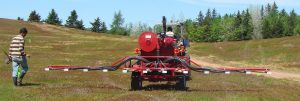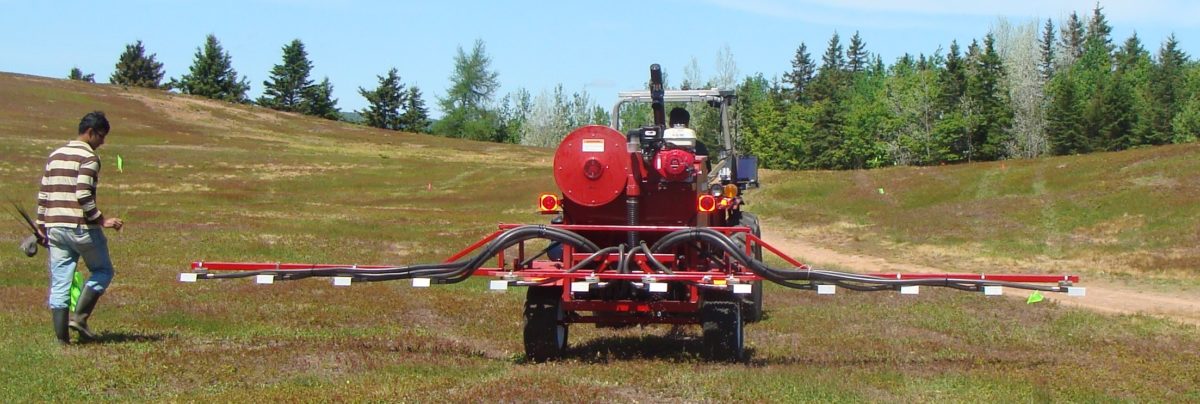
Figure 1. A rear view of the Valmar fertilizer spreader shows the dry boom with hoses and 12 nozzles.
By Arnold Schumann, Qamar Zaman, Hassan Chattha, Scott Read and Aitazaz Farooque
The wild blueberry (Vaccinium angustifolium) is a perennial, shrubby, slow-growing plant that is native to northeastern North America. Commercial wild blueberry fields are developed by removing competing vegetation and debris from natural mixed forest, because they cannot be successfully planted. Establishment of a commercially productive field of wild blueberry therefore takes time (often 10 or more years) and is achieved by selective encouragement of the blueberry plants at the expense of unwanted vegetation.
Fertilization with dry, granular nutrient formulations is an important part of the wild blueberry management program. Typical wild blueberry fields can have up to 50 percent bare and weedy spots, but existing fertilizer applicators dispense fertilizer uniformly across the entire field, thus promoting growth of both weeds and blueberries.
TARGETED FERTILIZER TECHNOLOGY
In research collaboration between the University of Florida and Dalhousie University in Nova Scotia, a Valmar 1255 pull-type broadcast applicator (Figure 1) was modified to deliver targeted dry fertilizer only to the patches of wild blueberry plants, while avoiding the bare patches and weeds. The unmodified Valmar spreader in a “dry boom” broadcast configuration uses a blower fan and separate piped airstreams to dispense precisely metered amounts of dry fertilizer from 12 discharge nozzles (see Figure 1, white objects on the boom). The streams of fertilizer overlap on the ground, thus creating an application pattern which is much more uniform than that from a spinner-type broadcast fertilizer spreader.
Other features of the fertilizer spreader include automatic dose adjustment according to ground speed, achieved via variable-speed, grooved dosing rollers and venturi suction points to inject the granules into the 12 airstreams (visible as separate hoses in Figure 1). To reduce the complexity of the modified spreader, only six independent variable-rate channels were created, meaning adjacent pairs of nozzles were grouped and regulated at the same application rate, each covering a swath of approximately 4 feet on the ground. Regulation of fertilizer flow for the six channels was achieved by adding electric solenoid valves that actuated pneumatic cylinders to open or close the fertilizer flow into each venturi.
A new challenge was encountered whereby the time of flight for fertilizer particles differs proportionately according to the length of the air delivery pipe to each nozzle position on the dry boom. For example, if channel 1 and 3 open or shut off at the same time, the stream of fertilizer will be delayed in channel 3 due to its longer hose, thus causing unacceptable misapplications on the ground. A simple solution might be to use equal lengths of hose for all the channels, with surplus hose being coiled up on the boom. Unfortunately, the hose coils create variable friction for the flow of air and fertilizer, which again leads to inaccuracy.
The engineering team at Dalhousie finally settled on using a programmable logic controller to introduce different calibrated time delays into the digital on/off commands received for each channel. This innovation solved the problem and allowed accurately synchronized fertilizer dosing from each of the six variable-rate channels. Other equipment added to the fertilizer spreader included a variable-rate controller and differential global positioning systems for controlling the solenoid valves, and six digital color cameras with a ruggedized laptop computer for detecting the blueberry crop, weeds and bare patches on the ground using machine vision.
RESEARCH RESULTS AND RAMIFICATIONS
The modified spreader was evaluated under two different lighting conditions and three ground speeds. The effectiveness of its variable fertilizer application pattern compared to unmodified broadcast applicators was measured by using fertilizer collection devices in a field’s blueberry, bare soil and weed areas and comparing fertilizer samples after using each system. Results of this study demonstrated that the modified spreader was capable of detecting blueberry plants, bare spots and weeds for variable application of fertilizer, which ensured that only the blueberry plants were fertilized.
This precision fertilization practice can immediately reduce wasted agrochemical, increase farm profitability and protect the environment from off-target fertilizer. The application technology could potentially be adapted to other specialty crops or turfgrass requiring accurate variable rates of dry fertilizer.
Acknowledgements: This material is based upon work supported by Oxford Frozen Foods, the Canada Foundation for Innovation and the Wild Blueberry Producers Association of Nova Scotia.
Arnold Schumann (schumaw@ufl.edu) is a professor at the University of Florida Institute of Food and Agricultural Sciences Citrus Research and Education Center in Lake Alfred and adjunct professor in the Mechanical Engineering Department of Dalhousie University, Nova Scotia, Canada. Qamar Zaman (qzaman@dal.ca) is a professor and Scott Read (scott.read@dal.ca) is a senior instructor at the Department of Engineering, Faculty of Agriculture, Dalhousie University. Aitazaz Farooque (afarooque@upei.ca) is an assistant professor at the School of Sustainable Design Engineering, University of Prince Edward Island, Canada. Hassan Chattha (hassan.chattha@rentokil.com) is a pest control specialist with Rentokil North America in Winnipeg, Canada.
This article was featured in the July issue of VSCNews magazine. Click here to receive future issues of VSCNews magazine.
Share this Post










